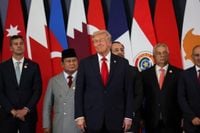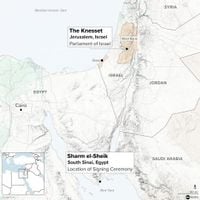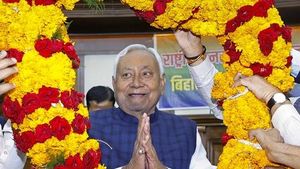As the dust settles over the Gaza Strip, a fragile peace is taking root after two years of relentless conflict between Israel and Hamas. The ceasefire, brokered by the United States and announced on October 10, 2025, marks a tentative turning point, but the road ahead is anything but straightforward. Behind closed doors, world leaders and negotiators are grappling with the daunting task of turning a war-torn enclave into a stable, self-governing region—one that can guarantee security for both its people and its neighbors.
At the heart of this effort is a 20-point peace plan unveiled by U.S. President Donald Trump at the end of September. According to The Wall Street Journal, the plan’s first phase called for a ceasefire and the release of all hostages, living and deceased. By October 13, these goals had largely been met: Israeli forces withdrew to an agreed line, fire ceased, and 20 living hostages returned home to Israel. In exchange, Israel released around 2,000 Palestinian prisoners, a move that was met with celebration and cautious optimism in Gaza and the West Bank.
Yet, the process has been fraught with complications. Hamas was initially tasked with releasing all 48 hostages—alive or dead—within 72 hours. However, as ABC News reported, only seven sets of remains were handed over by the deadline, and one set did not match any known hostages, according to the Israel Defense Forces. Israeli families, already on edge, were incensed by the delays, and Defense Minister Israel Katz warned that any intentional holdup would be considered a violation of the agreement. The pressure to return all hostages remains high, and another transfer of remains was expected on October 15, with Egyptian and Turkish teams continuing recovery operations based on Israeli-provided coordinates.
President Trump, ever the showman, traveled to Israel and Egypt on October 13 to celebrate what he called the “success of the first phase” of his peace agreement. Addressing world leaders in Sharm el-Sheikh, he declared, “A new and beautiful day is rising and now the rebuilding begins.” Trump’s optimism was tempered by realism: “The path to peace will be winding,” he admitted, noting that the phases of the deal are “all a little bit mixed in with each other.” He later added, “We can be long advanced on some of the things that we say we're going to do. We can take them out of order in a positive way.”
The second phase of the Trump plan is now underway, focusing on the daunting tasks of postwar governance, security arrangements, and the gradual disarmament of Hamas. According to The Media Line, Egypt has proposed deploying up to 10,000 Palestinian security personnel in Gaza. The initial force—about 1,000 officers trained in Egypt and Jordan—would help stabilize the territory and enforce security after the ceasefire. Egyptian officials hope to expand this contingent over time, but Israel is expected to resist any arrangement involving the Palestinian Authority or a sizable armed Palestinian presence in Gaza.
Central to the plan is the creation of an International Stabilisation Force (ISF) under Arab and international supervision. This force would oversee the transition, serve as a buffer between Israel and Hamas, and train vetted police forces in Gaza. Yet, as diplomats told the Financial Times, the size, remit, and makeup of the ISF remain unclear. Arab governments are reportedly wary of participating, fearing they could be seen as occupiers. “Unless there is clear buy-in from Palestinian elements on the ground (to include Hamas, which opposes the idea), it is hard to imagine any Arab forces willing to deploy on the ground,” assessed the Centre for Strategic and International Studies.
The disarmament of Hamas—a key pillar of the Trump plan—remains a sticking point. While the plan calls for Hamas to lay down its weapons and hand over power to a technocratic, apolitical transitional government, Hamas has flatly rejected the notion of disarmament. A Hamas source told AFP that disarmament is “out of the question.” Despite this, Trump suggested that Hamas has been given approval to act as a Palestinian police force in Gaza “for a period of time.” When asked about reports of Hamas rearming, he said, “they are standing because they do want to stop the problems, and they’ve been open about it, and we gave them approval for a period of time.”
As for governance, the transitional authority is envisioned as technocratic and apolitical, overseen by an international “Board of Peace.” The Palestinian Authority, led by Mahmoud Abbas, is a possible candidate to take over, but its popularity among Palestinians is low and Israeli Prime Minister Benjamin Netanyahu has already rejected PA rule in Gaza. According to Edmund Fitton-Brown, a former British ambassador, Gaza could see the “gradual, and potentially highly problematic” creation of a Jordanian-Egyptian trained Palestinian police force under the supervision of the Board of Peace and reinforced by the ISF.
Meanwhile, the humanitarian crisis in Gaza remains acute. The ceasefire has allowed the unrestricted flow of aid through the Kerem Shalom crossing, with up to 600 trucks entering daily as stipulated in the agreement. According to the United Nations Development Programme, the two-year war has generated at least 55 million tons of rubble and left much of Gaza’s infrastructure in ruins. The UN estimates the cost of rebuilding at up to $70 billion—a staggering figure that will require support from the United States, Arab states, and Europe. Jaco Cilliers, a UNDP official, said, “There are very good indications” that international partners are willing to contribute, but warned that full reconstruction could take a decade or even longer.
The war’s toll has been devastating. Palestinian health authorities report more than 67,000 people killed in Gaza, nearly a third of them children. The conflict began with a Hamas incursion into southern Israel on October 7, 2023, which killed about 1,200 people and resulted in 251 hostages—the bloodiest day in Israel’s history. Israel’s finance minister Bezalel Smotrich estimated the war’s cost to Israel at 300 billion shekels (about £67.87 billion).
Logistical issues still loom large, including the reopening of the Rafah crossing between Gaza and Egypt, which was supposed to resume operations after the first phase of the agreement. Israeli officials say the continued closure gives them leverage in negotiations over the return of additional hostage remains. So far, Israel has returned 45 Palestinian bodies in exchange for three deceased hostages—a grim but telling sign of the complexity and sensitivity of the ongoing talks.
Officials familiar with the negotiations say that while progress is steady, finalizing the security arrangements and defining Gaza’s postwar administration will take time. The ceasefire is holding, but the challenges of disarmament, governance, and rebuilding are immense. The world is watching to see whether this fragile peace can hold—and whether Gaza can finally emerge from the shadow of war.





